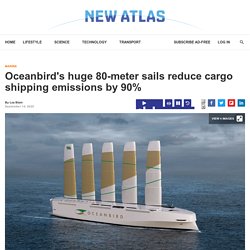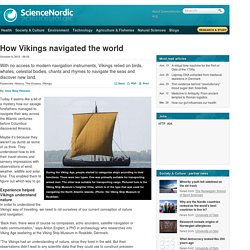

Driven by Perfection. Oceanbird's huge 80-meter sails reduce cargo shipping emissions by 90% The idea of using sails to power a boat is not exactly a new one; indeed, the earliest known depiction of a ship under sail appears on a painted disc found in Kuwait, dated back to somewhere between 5,000-5,500 BCE.

Boats themselves, interestingly, appear to be closer to a million years old, and were used by homo erectus long before neanderthals or homo sapiens ever walked the Earth. Sails propelled humanity around the globe for thousands of years, before being relegated mainly to recreational use over the last couple of hundred years by the development of steam technology and internal combustion engines, among other things, which developed more reliable propulsion across a wider range of conditions and use cases.
Fuel-burning ships have been phenomenally successful, opening up the global trade network we enjoy today, but we may not have seen the end of sails just yet. Oceanbird Wallenius Marine - Introducing Oceanbird Source: Oceanbird. New CGI of How Titanic Sank. 48 Wallytender yacht features folding walls for expansive fun in the Sun. Deepflight creates a new class of personal water travel with dragon submersible. Nov 05, 2015 deepflight creates a new class of personal water travel with dragon submersible deepflight creates a new class of personal water travel with dragon submersible all images courtesy of deepflight deepflight, was founded in 1996 by ocean engineer graham hawkes. together with a group of seasoned designers and engineers, they’ve developed a fundamentally new type of personal submarining that is a combination submersible and high-performance aircraft called ‘dragon’. it offers the freedom to chart flexible explorations the ‘dragon’ has a fixed positive buoyancy, meaning that it will always naturally float back to the surface. it offers a proprietary technology that monitors and manages critical functions, allowing users to pilot the submarine with minimal training and provides the ability to set the depth limit on any particular dive. designers incorporated both classical submersible technology and race track dynamics.

What the hell is a cargo cruise? Magnificent, that's what. While the frilly amenities on cruise ships vary, from ice rinks to ziplines to planetariums, some things remain constant: Awful buffets, deck chair wars, shuffle board, and partying Spring Breakers.

Also, getting stranded at sea and having to pee in a bucket. Sometimes. Which is why, instead of going the traditional route, you, the intrepid anti-tourist, should book yourself on the voyage less traveled – on a cargo ship. Yes, indeed, savvy adventurers can ride along on freighters -- no stowing away necessary. And with that in mind, we’ve compiled everything you need to know about cruisin’ slowly amid a hundred crates of Brazilian bananas. Seven Days on the Queen Mary 2. Paddle Away From Civilization: 4 Amazing Wilderness Canoe Trips to Take. How Vikings navigated the world. During the Viking Age, people started to categorise ships according to their functions.

There were two types. One was primarily suitable for transporting armed men. The other was suitable for transporting cargo. Pictured here is the Viking Ship Museum’s freighter Ottar, which is of the type that was used for navigating the North Atlantic islands. (Photo: the Viking Ship Museum in Roskilde). Today it seems like a bit of a mystery how our savage forefathers managed to navigate their way across the Atlantic centuries before Columbus discovered America. Maybe it’s because they weren’t as dumb as some of us think. Experience helped Vikings understand nature In order to understand the Vikings’ way of travelling, we need to rid ourselves of our current conception of nature and navigation: Exploring The World's Eeriest Shipwrecks (PHOTOS) After Hurricane Isaac uncovered a shipwreck apparently hidden beneath the sands of an Alabama beach, curious locals learned an unexpected lesson in maritime history while visiting the photogenic hull.

Shipwrecks, it seem, exert a very specific type of gravity. They are like train wrecks caught mid-horror and, no, people can't look away. The best example of this phenomenon may well be the wreck of the Salem Express, which sits in the Red Sea. The wreck was recent enough -- the ship went down in 1991 -- that no one struggles to remember the lives that were lost as the ferry sank into the sea after striking a reef, but the wreck is already a huge attraction for divers, who can still see the luggage that still sits in the hull.